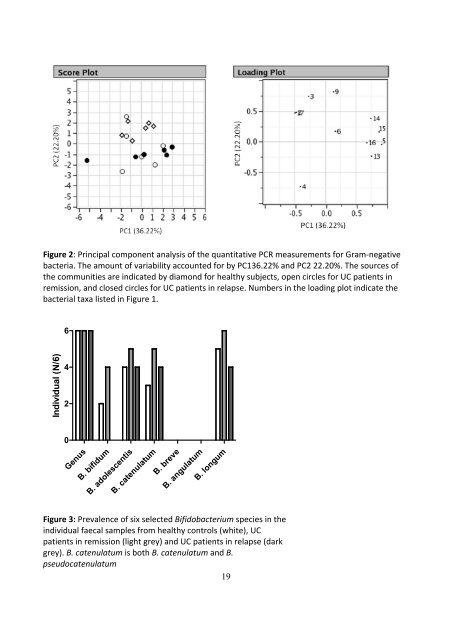- Page 1:
Role of Intestinal Microbiota in Ul
- Page 4 and 5:
Role of Intestinal Microbiota in Ul
- Page 6 and 7:
Preface Preface This thesis present
- Page 8 and 9:
Summary Summary The microbiota of t
- Page 10 and 11:
Dansk sammendrag Dansk sammendrag M
- Page 12 and 13:
Introduction and objectives Introdu
- Page 14 and 15:
List of Manuscripts Not included in
- Page 16 and 17:
List of contents List of Centents P
- Page 18 and 19:
List of Centents Methodology append
- Page 21 and 22:
1. The intestinal environment Theor
- Page 23 and 24:
Theoretical part 5 1. The intestina
- Page 25 and 26:
2. The colonic environment Theoreti
- Page 27 and 28: Theoretical part 9 2. The colonic e
- Page 29 and 30: Table 1: The presence of glycoside
- Page 31 and 32: Theoretical part Figure 3: The colo
- Page 33 and 34: 3. Inflammatory Bowel disease Theor
- Page 35 and 36: Theoretical part 17 3. Inflammatory
- Page 37 and 38: Theoretical part 19 4. Modulation o
- Page 39 and 40: Theoretical part 21 4. Modulation o
- Page 41 and 42: Theoretical part 23 4. Modulation o
- Page 43 and 44: Table 4: Clinical trials on the pre
- Page 45 and 46: Theoretical part 5. Production of p
- Page 47 and 48: Theoretical part 5. Production of p
- Page 49 and 50: Theoretical part 5. Production of p
- Page 51: Methodology part
- Page 54 and 55: Methodology part 6. Methodology, co
- Page 56 and 57: Methodology part 6. Methodology, co
- Page 58 and 59: Methodology part 6. Methodology, co
- Page 60 and 61: Introduction Methodology part 42 Pa
- Page 62 and 63: Abstract Background Detailed knowle
- Page 64 and 65: depending the level of disease acti
- Page 66 and 67: in 1 x TAE at 60 °C for 16 h at 36
- Page 68 and 69: Statistics PCA were generated by SA
- Page 70 and 71: The PCA of the Gram‐positive bact
- Page 72 and 73: layer of UC patients and found that
- Page 74 and 75: Acknowledgements The authors thank
- Page 76 and 77: Table 2 ‐ 16S rRNA gene and 16S
- Page 80 and 81: Supplementary Figure S1. Dice clust
- Page 82 and 83: Reference List 1. Ahmed S, Macfarla
- Page 84 and 85: 32. Matsuki T, Watanabe K, Fujimoto
- Page 87 and 88: Methodology part Paper 2 Fecal lact
- Page 89 and 90: Fecal lactobacilli and bifidobacter
- Page 91 and 92: Introduction The mucus layer lining
- Page 93 and 94: efore enrolment and there was no si
- Page 95 and 96: (Bio‐Rad Labs, Hercules, Californ
- Page 97 and 98: Microbial community analysis using
- Page 99 and 100: difference from the luminal microbi
- Page 101 and 102: that C. coccoides group and C. lept
- Page 103 and 104: Table 1 ‐ 16S rRNA gene of phylum
- Page 105 and 106: Table 2 ‐ Preference of bacterial
- Page 107 and 108: Figure 1. A) Schematic overview of
- Page 109 and 110: A. B. Figure 3. Principal component
- Page 111 and 112: 15. Fooks LJ, Gibson GR. (2002) In
- Page 113 and 114: 47. Ouwehand AC, Suomalainen T, Tol
- Page 115 and 116: Methodology part Paper 3 Paper 3 In
- Page 117 and 118: APPLIED AND ENVIRONMENTAL MICROBIOL
- Page 119 and 120: 8338 VIGSNÆS ET AL. APPL. ENVIRON.
- Page 121 and 122: 8340 VIGSNÆS ET AL. APPL. ENVIRON.
- Page 123 and 124: 8342 VIGSNÆS ET AL. APPL. ENVIRON.
- Page 125: 8344 VIGSNÆS ET AL. APPL. ENVIRON.
- Page 128 and 129:
Methodology part Introduction The a
- Page 130 and 131:
Journal of Agricultural and Food Ch
- Page 132 and 133:
Journal of Agricultural and Food Ch
- Page 134 and 135:
Journal of Agricultural and Food Ch
- Page 136 and 137:
Journal of Agricultural and Food Ch
- Page 139 and 140:
Methodology part Paper 5 Paper 5 Ma
- Page 141 and 142:
Appl Microbiol Biotechnol (2011) 90
- Page 143 and 144:
Appl Microbiol Biotechnol (2011) 90
- Page 145 and 146:
Appl Microbiol Biotechnol (2011) 90
- Page 147 and 148:
Appl Microbiol Biotechnol (2011) 90
- Page 149 and 150:
Appl Microbiol Biotechnol (2011) 90
- Page 151 and 152:
Appl Microbiol Biotechnol (2011) 90
- Page 153 and 154:
Methodology part Paper 6 Tailored e
- Page 155 and 156:
Process Biochemistry 46 (2011) 1039
- Page 157 and 158:
Table 1 List of enzymes. Enzyme Sou
- Page 159 and 160:
J. Holck et al. / Process Biochemis
- Page 161 and 162:
Intensity 50 0 C1 175.05 J. Holck e
- Page 163 and 164:
J. Holck et al. / Process Biochemis
- Page 165:
[29] Bauer S, Vasu P, Persson S, Mo
- Page 168 and 169:
Methodology part 150
- Page 170 and 171:
Methodology part 152 Appendix 1 hor
- Page 172 and 173:
Appendix 3 Methodology part Appendi
- Page 174 and 175:
Methodology part 156 Appendix 3
- Page 177 and 178:
7. Discussion and perspectives Disc
- Page 179 and 180:
Discussion and conclusion 161 7. Di
- Page 181 and 182:
Discussion and conclusion 163 7. Di
- Page 183 and 184:
Discussion and conclusion 165 7. Di
- Page 185 and 186:
References References Abreu,M.T., V
- Page 187 and 188:
References Derrien,M., Vaughan,E.E.
- Page 189 and 190:
References Haarman,M. and Knol,J. (
- Page 191 and 192:
References Lantz,P.G., Matsson,M.,
- Page 193 and 194:
References Matsuki,T., Watanabe,K.,
- Page 195 and 196:
References Pullan,R.D., Thomas,G.A.
- Page 197 and 198:
References Tannock,G.W. (2010). Ana
- Page 200:
National Food Institute Technical U
















